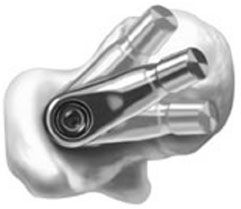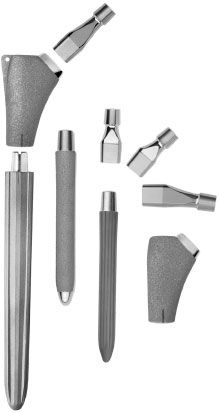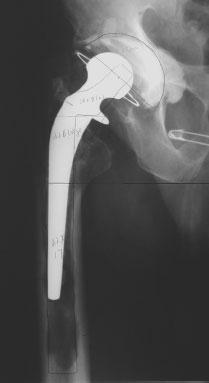FIGURES 23-1. A: The figure shows a proximally modular revision hip stem implanted immediately postoperatively. There is a calcar replacement body in place with allograft struts and cerclage wires. B: The figure shows the same femur 3 years later. The x-ray shows incorporation of the bone graft and densification of the bone adjacent to and below the porous sleeve.
Another important advantage of a proximally modular system is the ability to accommodate variations in neck length, offset, proximal femoral version, and proximal-distal size mismatches. Unusual anatomic variation is common in femoral revision and is most commonly caused by bone loss or bone remodeling related to the progressive failure of the index arthroplasty. Typically, a loose femoral stem will fall into varus and retroversion due to the predominant proximal femoral stresses created during in vivo loading, causing a corresponding proximal femoral adaptation (Fig. 23-2). As a consequence of bone remodeling, the most commonly encountered anatomic variations in the revision femur are proximal-distal size mismatches and retroversion/varus remodeling of the proximal femur. This type of size mismatch is not only the most common but also the best managed with modularity. Through modularity, the deformity in each segment of the femur can be independently addressed, with the final implant providing a combination of sizes and implant positions that match the deformity. Implant system modularity will allow the combination of a large or small proximal body with a larger or smaller distal stem configuration, in addition to providing options in neck length, offset, and version. Thus, the final implant construct can be customized to the peculiar size requirements of the revision femur.
FIGURE 23-2. The figure shows a loose cemented stem in the proximal femur. The loose stem has fallen into varus creating proximal femoral remodeling and expansion of the endosteum. The pattern of stem movement and bone adaptation is common with loosened cemented hip stems.
SURGICAL TECHNIQUE
The surgical technique for proximally modular systems is based upon accurate bone preparation and rebuilding the femur from the diaphysis up to the proximal femur. The diaphyseal preparation starts first and is performed with either cylindrical or tapered reamers, depending upon the shape and design of the distal portion of the stem. Many proximally modular systems also offer distal modularity. Distal modularity includes variable lengths of stems, straight and curved stems, solid and slotted stems, tapered and cylindrical stems, and extensively coated or smooth stems with endosteal-engaging flutes. In order for a proximally modular stem to optimize proximal femoral loading, the distal portion of the stem should confer rotational stability without distal fixation. Additionally, the distal stem chosen should be the shortest stem required to bypass cortical defects and support the proximal sleeve. The longer the distal stem, the greater the proximal stress shielding.
Once the distal femur is prepared to the appropriate specifications based upon bone defects and size requirements, the proximal femur is prepared, and finally, the proximal and distal components are joined to create a trial implant configuration. From the trial stem and body platform, the appropriate neck length and offset can be determined during the trial reduction of the head into the acetabular socket. Likewise, in the case of retroversion deformity, the proximal body of the implant can be oriented with regard to the bone deformity while the neck of the implant is oriented independently to restore the appropriate anteversion (Fig. 23-3). To emphasize, the stem and neck are placed to reconstitute the noindent proximal femoral anteversion independent of the position of the proximal body of the implant. Additionally, alterations in soft tissue tension related to changes in hip center, capsular scar formation, and abductor weakness require a femoral system that can be adjusted intraoperatively to restore anatomic relationships. Generally, these alterations in hip center and offset are accommodated by neck and proximal body options allowing noindent or increased offset and neck length (Fig. 23-4).

FIGURE 23-3. Illustrated in this picture is a representation of how the femoral component anteversion can be adjusted with a modular hip stem. The anterversion of the stem can be placed in the appropriate position to restore hip mechanics and stability. The proximal body can be placed in a position independent of the distal stem configuration. (Picture courtesy of Zimmer, Inc, Warsaw, IN.)

FIGURE 23-4. The figure shows a proximally modular hip revision system with a full array of modularity. The system depicts modular junctions at the head-neck, neck–proximal body, and proximal body–distal stem interfaces. (Picture courtesy of Wright Medical Technologies, Memphis, TN.)
Accurate bone preparation is the other key requirement for success of the proximally modular system. Like any cementless implant system that achieves fixation through bone attachment to the implant, a proximal coating requires ideal fit and stability. Close proximity of the biologically active implant surface to the available bone as well as primary implant stability are the prerequisites to bone attachment. Bone ingrowth is inhibited when gaps exist between the implant and the bone endosteum or when movement occurs between the implant and the bone. For a modular implant system, fit and stability of the porous surface are generally achieved by exact milling of the bone surface. Bone in the proximal femur is often sclerotic, brittle, and noncompliant, thus less amenable to preparation by a broach. The milling of bone provides a more accurate preparation of the bone surface to fit the implant, especially in the setting of sclerotic and brittle bone. When the proximal bone is structurally or biologically compromised, further stability of the implant is afforded by increasing the length of the stem, and engaging the shaft of the femur with distal flutes.
It is difficult to perform a trochanteric osteotomy and not compromise the fixation with a proximally modular device, but authors have reported success using a proximally modular device in combination with an extended trochanteric osteotomy and stable cerclage fixation (Bierbaum, personal communication). In such cases, the extended osteotomy should be rigidly fixed with cerclage cables or wires after removal of the primary arthroplasty. Once the osteotomy is securely fixed, the proximal preparation for the modular stem proceeds in the same manner as when an osteotomy is not performed.
Stay updated, free articles. Join our Telegram channel

Full access? Get Clinical Tree









